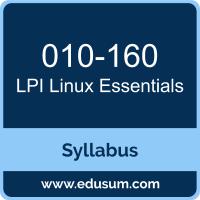 Use this quick start guide to collect all the information about LPI Linux Essentials (010-160) Certification exam. This study guide provides a list of objectives and resources that will help you prepare for items on the 010-160 LPI Linux Essentials - 010 exam. The Sample Questions will help you identify the type and difficulty level of the questions and the Practice Exams will make you familiar with the format and environment of an exam. You should refer this guide carefully before attempting your actual LPI Linux Essentials 010 certification exam.
Use this quick start guide to collect all the information about LPI Linux Essentials (010-160) Certification exam. This study guide provides a list of objectives and resources that will help you prepare for items on the 010-160 LPI Linux Essentials - 010 exam. The Sample Questions will help you identify the type and difficulty level of the questions and the Practice Exams will make you familiar with the format and environment of an exam. You should refer this guide carefully before attempting your actual LPI Linux Essentials 010 certification exam.
The LPI Linux Essentials certification is mainly targeted to those candidates who want to build their career in Essentials domain. The LPI Linux Essentials exam verifies that the candidate possesses the fundamental knowledge and proven skills in the area of LPI Linux Essentials 010.
LPI Linux Essentials Exam Summary:
| Exam Name | LPI Linux Essentials |
| Exam Code | 010-160 |
| Exam Price | $120 (USD) |
| Duration | 60 mins |
| Number of Questions | 40 |
| Passing Score | 500 / 800 |
| Books / Training | Linux Essentials Version: 1.6 |
| Schedule Exam | Pearson VUE |
| Sample Questions | LPI Linux Essentials Sample Questions |
| Practice Exam | LPI 010-160 Certification Practice Exam |
LPI 010-160 Exam Syllabus Topics:
| Topic | Details |
|---|---|
The Linux Community and a Career in Open Source |
|
| Linux Evolution and Popular Operating Systems |
Weight: 2 Key Knowledge Areas:
The following is a partial list of the used files, terms and utilities:
|
| Major Open Source Applications |
Weight: 2 Key Knowledge Areas:
The following is a partial list of the used files, terms and utilities:
|
| Open Source Software and Licensing |
Weight: 1 Key Knowledge Areas:
The following is a partial list of the used files, terms and utilities:
|
| ICT Skills and Working in Linux |
Weight: 2 Key Knowledge Areas:
The following is a partial list of the used files, terms and utilities:
|
Finding Your Way on a Linux System |
|
| Command Line Basics |
Weight: 3 Key Knowledge Areas:
The following is a partial list of the used files, terms and utilities:
|
| Using the Command Line to Get Help |
Weight: 2 Key Knowledge Areas:
The following is a partial list of the used files, terms and utilities:
|
| Using Directories and Listing Files |
Weight: 2 Key Knowledge Areas:
The following is a partial list of the used files, terms and utilities:
|
| Creating, Moving and Deleting Files |
Weight: 2 Key Knowledge Areas:
The following is a partial list of the used files, terms and utilities:
|
The Power of the Command Line |
|
| Archiving Files on the Command Line |
Weight: 2 Key Knowledge Areas:
The following is a partial list of the used files, terms and utilities:
|
| Searching and Extracting Data from Files |
Weight: 3 Key Knowledge Areas:
The following is a partial list of the used files, terms and utilities:
|
| Turning Commands into a Script |
Weight: 4 Key Knowledge Areas:
The following is a partial list of the used files, terms and utilities:
|
The Linux Operating System |
|
| Choosing an Operating System |
Weight: 1 Key Knowledge Areas:
The following is a partial list of the used files, terms and utilities:
|
| Understanding Computer Hardware |
Weight: 2 Key Knowledge Areas:
The following is a partial list of the used files, terms and utilities:
|
| Where Data is Stored |
Weight: 3 Key Knowledge Areas:
The following is a partial list of the used files, terms and utilities:
|
| Your Computer on the Network |
Weight: 2 Key Knowledge Areas:
The following is a partial list of the used files, terms and utilities:
|
Security and File Permissions |
|
| Basic Security and Identifying User Types |
Weight: 2 Key Knowledge Areas:
The following is a partial list of the used files, terms and utilities:
|
| Creating Users and Groups |
Weight: 2 Key Knowledge Areas:
The following is a partial list of the used files, terms and utilities:
|
| Managing File Permissions and Ownership |
Weight: 2 Key Knowledge Areas:
The following is a partial list of the used files, terms and utilities:
|
| Special Directories and Files |
Weight: 1 Key Knowledge Areas:
The following is a partial list of the used files, terms and utilities:
|
To ensure success in LPI Linux Essentials 010 certification exam, we recommend authorized training course, practice test and hands-on experience to prepare for LPI Linux Essentials - 010 (010-160) exam.
